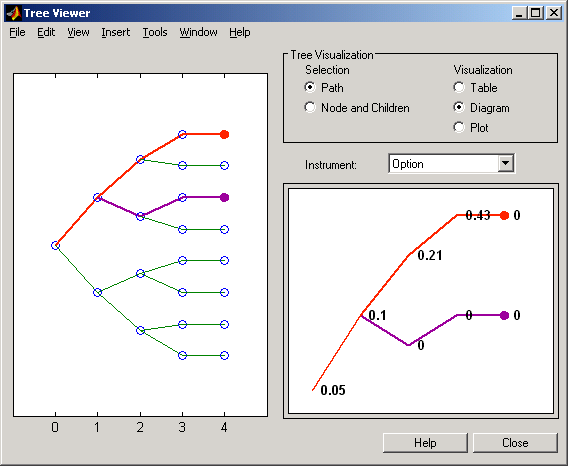treeviewer
Tree information
Description
treeviewer(
displays a tree of instrument prices. PriceTree,InstSet)
If you provide the name of an instrument set (InstSet) and you have
named the instruments using the field Name, the
treeviewer display identifies the instrument being displayed with its
name. (See Example 3 for a description.) If
you do not provide the optional InstSet input argument, the instruments
are identified by their sequence number in the instrument set. (See Example
6 for a description.)
treeviewer(
displays a cash flow tree that has been created with CFTree,InstSet)swapbybdt or swapbyhjm. If you provide the name of an
instrument set (InstSet) containing cash flow names, the
treeviewer display identifies the instrument being displayed with its
name. (See Example 3 for a description.) If
the optional InstSet argument is not present, the instruments are
identified by their sequence number in the instrument set. See Example
6 for a description.)
Examples
Display an HJM Interest-Rate Tree
load deriv.mat
treeviewer(HJMTree)
The treeviewer function displays the structure of an HJM tree in the
left pane. The tree visualization in the right pane is blank.

To visualize the actual interest-rate tree, go to the Tree
Visualization pane and clickPath(the default) and
Diagram. Now, select the first path by clicking the last node
(t = 3) of the upper branch.

The entire upper path is highlighted in red.
To complete the process, select a second path by clicking the last node
(t = 3) of another branch. The second path is highlighted in
purple. The final display looks like this.

Alternative Forms of Display
The Tree Visualization pane allows you to select alternative ways to display tree data. For example, if you select Path and Table as your visualization choices, the final display above instead appears in tabular form.

To see a plot of interest rates along the chosen branches, click Path and Plot in the Tree Visualization pane.

With Plot selected, rising interest rates are shown on the upper branch and declining interest rates on the lower.
Finally, if you clicked Node and Children under Tree Visualization, you restrict the data displayed to just the selected parent node and its children.

With Node and Children selected, the choices under Visualization are unavailable.
Display a BDT Interest-Rate Tree
load deriv.mat treeviewer(BDTTree)
The treeviewer function displays the structure of a BDT
tree in the left pane. The tree visualization in the right pane is blank.

To visualize the actual interest-rate tree, go to the Tree
Visualization pane and click Path (the default) and
Diagram. Now, select the first path by clicking the first node of the
up branch (t = 1). Continue by clicking the down branch at the
next node (t = 2). The two figures below show the treeviewer
path diagrams for these selections.

Continue clicking all nodes in succession until you reach the end of the branch. The entire path you have selected is highlighted in red.
Select a second path by clicking the first node of the lower branch
(t = 1). Continue clicking lower nodes as you did on the
first branch. The second branch is highlighted in purple. The final display looks like
this.

Display an HJM Price Tree for Named Instruments
load deriv.mat
[Price, PriceTree] = hjmprice(HJMTree, HJMInstSet);
treeviewer(PriceTree, HJMInstSet)

Display a BDT Price Tree for Named Instruments
load deriv.mat
[Price, PriceTree] = bdtprice(BDTTree, BDTInstSet);
treeviewer(PriceTree, BDTInstSet)

Display an HJM Price Tree with Renamed Instruments
load deriv.mat [Price, PriceTree] = hjmprice(HJMTree, HJMInstSet); Names = {'Bond1', 'Bond2', 'Option', 'Fixed','Float', 'Cap',... 'Floor', 'Swap'}; treeviewer(PriceTree, Names)

Display an HJM Price Tree Using Default Instrument Names (Numbers)
load deriv.mat
[Price, PriceTree] = hjmprice(HJMTree, HJMInstSet);
treeviewer(PriceTree)
Input Arguments
More About
Version History
Introduced before R2006a